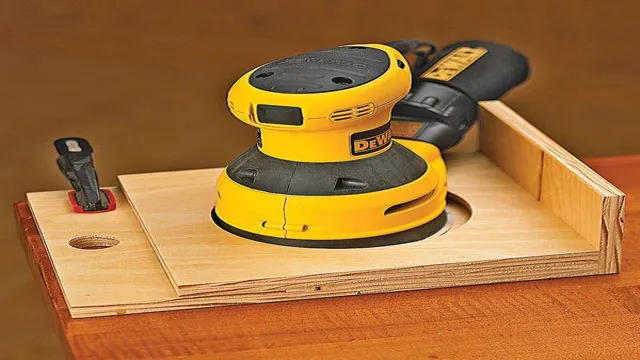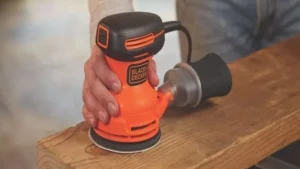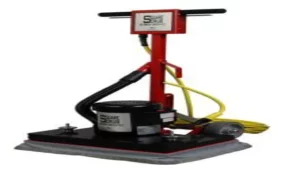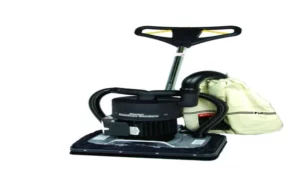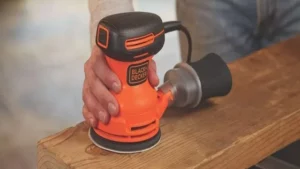Do you ever feel like you’re not getting the most out of your random orbital sander? Maybe you’ve noticed that it’s leaving noticeable swirl marks or isn’t removing material as efficiently as you’d like. It could be that you’re not using the ideal spin speed. The spin speed is a critical component of a sander’s performance, but finding the perfect setting can be challenging.
In this blog post, we’ll explain what the ideal spin speed is for a random orbital sander and why it matters. So, put your sanding gloves on, and let’s get into it!
Understanding Random Orbital Sanders
When it comes to random orbital sanders, the question of how fast they should spin is a common one. The speed of a random orbital sander is measured in orbits per minute (OPM) and can range from 6,000 to 12,000 OPM. The speed at which you should operate your sander largely depends on the material you are working with.
If you are sanding a softwood like pine, you should use a lower speed setting to avoid damaging the wood. On harder surfaces like oak, you can increase the speed for a more efficient sanding process. Keep in mind that higher speeds aren’t always better, as they can cause heat buildup and damage to the material.
It’s important to adjust the speed of your sander to the materials you’re working with.
What is a Random Orbital Sander?
A random orbital sander is a type of power tool used to sand various surfaces, such as wood, metal, and plastics. It is called random because it follows an unpredictable pattern while sanding, making it more efficient in removing material and minimizing swirl marks. The sander incorporates a circular sandpaper disc that spins on its axis while also moving in an elliptical pattern.
This dual-action allows the tool to remove more material with less effort compared to other sanding methods. A random orbital sander is versatile and can handle a wide range of sanding tasks, from smoothing rough wood or metal surfaces to removing old paint or finishes. It is often used in woodworking, metalworking, and automotive bodywork.
Its lightweight and ergonomic design make it easy and comfortable to use for extended periods. So, whether you are a DIY enthusiast or a professional, a random orbital sander should be on your list of must-have power tools.
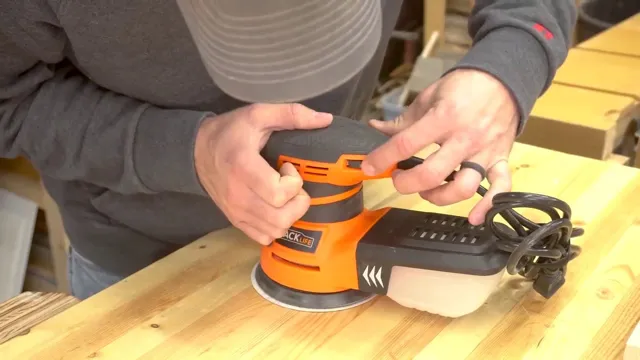
How Does a Random Orbital Sander Work?
A random orbital sander is a versatile and popular tool used for sanding wooden surfaces in preparation for finishing. It works by using a spinning disc attached to the motor that rotates in a circular motion while simultaneously vibrating in random directions. The sandpaper attached to the disc moves in an elliptical motion that eliminates the circular marks left by traditional rotary sanders, resulting in a smoother finish.
The randomizing action also prevents the sander from leaving unwanted swirl marks on the wood. As the sander moves over the surface, it removes the top layers of the wood, creating a smooth, even surface ready for staining, painting, or sealing. The oscillating motion also reduces the chance of overheating and clogging, giving the user a more efficient and consistent sanding experience.
Overall, understanding how a random orbital sander works is essential in achieving professional-looking results on any woodworking project.
Factors Affecting Spin Speed
When it comes to how fast a random orbital sander should spin, there are several factors that can affect its speed. One of the main determinants is the grit of the sandpaper being used. Coarser sandpapers require lower speeds since they remove more material quickly, while finer grits should be used at higher speeds to achieve a smoother finish without burning the surface.
Another factor is the type of material being sanded, with softer materials like pine calling for slower speeds than hardwoods like oak. Additionally, the diameter of the sanding disk and the motor’s power can affect the sander’s speed, with larger disks requiring higher speeds to maintain performance. Ultimately, finding the right speed comes down to experimenting with different variables and fine-tuning accordingly for each project.
So, there is no one-size-fits-all solution to how fast a random orbital sander should spin – it’s all about finding the sweet spot.
Size of the Disc
The size of the disc plays a significant role in determining its spin speed. This is because the circumference of a larger disc is greater than that of a smaller one, hence the larger disc covers more distance in one rotation, resulting in a higher spin speed. Additionally, the mass and weight distribution of the disc also affect the spin speed.
A disc with a higher mass will spin slower than a lighter one since more force is required to rotate the heavier disc. Moreover, the weight distribution of the disc can also affect the spin speed. A disc with an uneven weight distribution will spin unevenly, which can lead to wobbling and reduced spin speed.
Therefore, it is essential to consider the size, weight, and weight distribution of the disc while selecting one for playing disc sports. By doing so, you can ensure that you have a disc that spins smoothly and with the desired speed, making your game more enjoyable and competitive.
Power of the Motor
When it comes to spin speed, the power of the motor plays a crucial role in determining how fast the bowl will spin. A stronger motor means a faster spin, which can be beneficial for larger or heavier loads of laundry. However, there are other factors that can affect spin speed.
One of these factors is the weight of the load itself. A heavier load may not spin as fast as a lighter load, even with a powerful motor. Another factor is the balance of the load.
If the load is distributed unevenly, it can cause the machine to vibrate excessively and may result in a slower spin speed. Finally, the type of fabric being washed can also impact spin speed. Delicate fabrics may need to be spun at a slower speed to avoid damage, while heavier fabrics may require a faster spin to effectively remove excess moisture.
Overall, the power of the motor is important, but it’s not the only factor to consider when trying to achieve the perfect spin speed for each load.
Frequency of Use
Spin speed is a crucial component of any rotating machinery, and it is affected by several factors. One of the most significant factors is frequency of use. Over time, as a machine is used more frequently, its spinning speed may decrease due to wear and tear on the components.
Additionally, the environment in which the machine operates can also affect its spinning speed. For example, a machine that operates in a dusty environment may suffer from clogged bearings or other components that can slow it down. Other factors that can affect the spinning speed of a machine include lubrication and temperature.
Regular maintenance and monitoring of these factors can help ensure that the machine operates consistently and efficiently. By taking these factors into consideration, operators can maintain optimal spin speeds and extend the life of their equipment.
Recommended Spin Speeds
When it comes to using a random orbital sander, one of the key factors to consider is the recommended spin speed. Generally, the optimal speed for a random orbital sander is between 8,000 and 12,000 orbits per minute. However, some models may have a wider range of speed settings, and it’s important to adjust the speed based on the job at hand.
For example, a lower speed may be preferable when sanding delicate materials or when trying to achieve a finer finish. On the other hand, a higher speed may be necessary for removing more substantial amounts of material. It’s also worth noting that using the wrong speed setting can cause damage to the material you’re working on, so it’s important to read the manufacturer’s instructions carefully and adjust the speed accordingly.
With the right speed and technique, a random orbital sander can be a valuable tool for achieving a smooth and polished surface on a wide range of materials.
For Fine Sanding
When it comes to fine sanding, spin speed plays a crucial role in ensuring a quality finish. Choosing the right spin speed can help prevent damage to the surface being sanded, and also improve the overall effectiveness of the process. Generally, a slower spin speed is recommended for fine sanding, as it allows for greater control and precision.
A spin speed of around 4,000 to 5,000 RPM is ideal for finer sanding tasks, such as finishing woodwork or polishing metals. It’s important to note that different sanding materials may require different spin speeds, so it’s always a good idea to check the manufacturer’s recommendations beforehand. By selecting the appropriate spin speed for your fine sanding job, you can achieve a smooth and flawless finish with ease.
For Coarse Sanding
When it comes to coarse sanding, it is crucial to use the right spin speed to achieve the desired results without damaging the surface. Generally, lower spin speeds are recommended for coarse sanding since it allows the abrasive grits to penetrate the surface and remove more material at a time. A spin speed of around 3,000 to 4,000 RPM is considered suitable for most coarse sanding tasks.
However, it is always a good idea to refer to the manufacturer’s recommendations for the specific tool and attachment you are using. Keep in mind that using a too high spin speed can cause the abrasive grits to wear out faster and create excessive heat, leading to discoloration or even melting of the surface. By using the recommended spin speed, you can ensure efficient and safe sanding while maintaining the integrity of the surface you are working on.
So, the next time you are tackling a coarse sanding project, make sure to check the recommended spin speed for the best results.
Conclusion
In conclusion, the speed at which a random orbital sander should spin depends on a variety of factors such as the type of material being sanded, the grit of the sandpaper, and the desired finish. Just like a chef who adjusts the heat of their stove to cook a perfect meal, a skilled woodworker knows how to adjust the speed of their sander to achieve the desired result. So remember, when it comes to random orbital sanders, there’s no one-size-fits-all answer to the question of how fast it should spin.
It’s all about finding the right speed for the job at hand!”
FAQs
What is a random orbital sander?
A random orbital sander is a power tool that operates by spinning a sanding disk in a circular motion while also moving it in an elliptical pattern.
How fast should a random orbital sander spin?
The speed of a random orbital sander is measured in orbits per minute (OPM) and can range from 6,000 to 12,000 OPM. Generally, a higher OPM speed is better for finishing work, while a lower speed is better for removing material.
Can a random orbital sander be used for both wood and metal?
Yes, a random orbital sander can be used for both wood and metal as long as you use the appropriate sanding disk and grit.
What size sanding disk should I use with a random orbital sander?
Typically, a random orbital sander uses 5-inch or 6-inch sanding disks, but some models may be compatible with other sizes.
What is the difference between a random orbital sander and a palm sander?
A random orbital sander moves in an elliptical pattern and is less likely to leave swirl marks on the wood surface, while a palm sander moves in a circular pattern and may leave swirl marks.
How do I change the sanding disk on my random orbital sander?
To change the sanding disk on a random orbital sander, first, turn off the tool and unplug it. Then, press the disk release button or lift the lever, remove the old disk, and attach a new one.
Can I use my random orbital sander to polish surfaces?
Yes, you can use a random orbital sander with a polishing pad attachment to buff and polish surfaces. However, you may need to use a lower speed setting and a different type of polishing compound.
